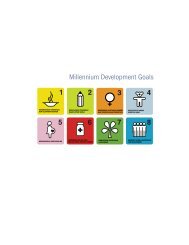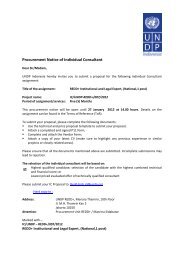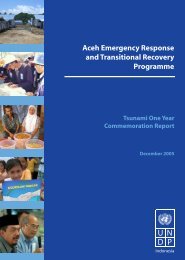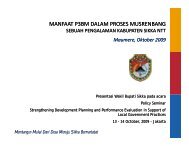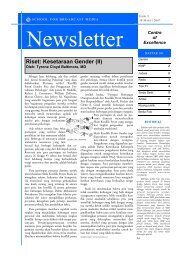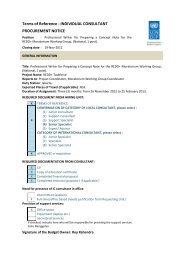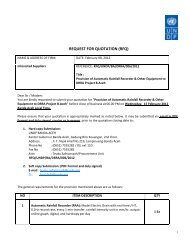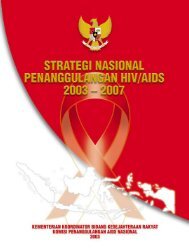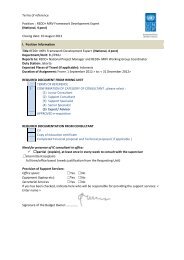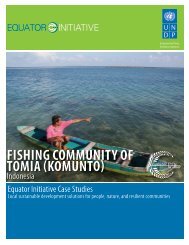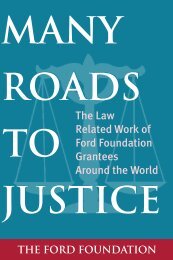Papua Needs Assessment - UNDP
Papua Needs Assessment - UNDP
Papua Needs Assessment - UNDP
You also want an ePaper? Increase the reach of your titles
YUMPU automatically turns print PDFs into web optimized ePapers that Google loves.
trillion per annum (roughly US $230 million, based on data of Rp.178.5 billion per month)<br />
(Cenderawasih Post cited in PNA reports, 2005).<br />
In <strong>Papua</strong>, much land considered to be the customary or adat land of local tribes and clans is now<br />
formally classified as state lands and large areas have been allocated as concessions to forestry<br />
and mining companies. Other areas constitute titled land or have been formally designated as<br />
national reserves. Still furtherareas of land remain adat land owned by local communities, used<br />
for subsistence activities, rented out to others or commissioned to forestry enterprises. At the<br />
same time, there is considerable overlap between areas, where multiple classifications exist and<br />
government allocations bear little resemblance to the resources – or their use- on the ground. The<br />
overall land use situation in <strong>Papua</strong> is thus relatively complex.<br />
Although a national-level set of laws on forestry and on marine fishery are in place, they have<br />
been unable to guarantee natural resource conservation or local communities’ rights to sustainably<br />
exploit the forests. The majority of local communities are highly reliant on natural resources for<br />
their daily needs as well as for incomes. An overview of <strong>Papua</strong>n ecosystems and the relationship<br />
between local people and livelihoods with these environments depicts this dependence (see<br />
box). In areas away from towns most of people’s material needs are met through the environment,<br />
whereas closer to towns people have more diverse means to income but also remain reliant on<br />
the surrounding environment. The forestry policy of licensing community co-operatives (Koperasi<br />
Masyarakat or ‘KOPERMAS’) may have been intended to allow local people to participate in and<br />
benefit from organised industry, however in <strong>Papua</strong> it is widely regarded as a means to legitimise<br />
illegal logging. KOPERMAS licences are offered to companies that in turn allow and encourage<br />
local people to log their forest areas without enforcement of environmental guidelines or regeneration<br />
activities. This practice generates short-term employment opportunities, but threatens longerterm<br />
uses.<br />
Overview of <strong>Papua</strong>n ecosytems, cultures and livelhood patterns<br />
Marshlands in coastal areas and rivers – approximately 21%* Mainly subsistence, depending<br />
on sago, fishing, hunting; growth season 3-6 months; remote from urban markets (Sarmi,<br />
Merauke, Mappi, Asmat, Waropen, Sorong South)<br />
Coastal areas - approximately 35%*<br />
Indigenous farmers live from subsistence farming (sago, gardening, pig husbandry, fishing)<br />
while transmigrant farmers live from soybeans, cassava, sweet potatoes and tree crops; growth<br />
season 10 months; sandy soils of moderate fertility (Biak Numfor, Supiori, Bay Wondama,<br />
Manokwari Yapen Waropen, Sorong, Fak Fak, Mimika)<br />
Highlands – approximately 28%*<br />
Population concentrated around Paniai lakes, in Baliem Valley, and eastern valleys, living from<br />
subsistence gardening, pig husbandry, heavy dependence on sweet potatoes; growth season<br />
10 months; living conditions poor with associated malnutrition; soil depths < 50cms and acidic<br />
(Entire mountain cordillera, Jayawijaya, Puncak Jaya, Paniai Pengunugan Bintang, Yahukimo,)<br />
Foothills and Valleys – approximately 16%*<br />
Scattered households, whole or mainly living from subsistence sectors, relying on gardening,<br />
pig husbandry, hunting and gathering food; growth season 10 month; shallow slope soils with<br />
complex accumulations of peat soils around the lakes. Living conditions worse than coastal<br />
rural zone, better than in swamps and riverine zone (Bird’s Head, Bird’s Neck, inner-land of Raja<br />
Empat, Keerom, Bintuni Bay, Boven Digul, Tolikara, Kaimana)<br />
* estimated % of total rural populations; based on data from Lavalin International 1998 (assorted<br />
preparatory documents in Integrated Area Development Programme).<br />
11



